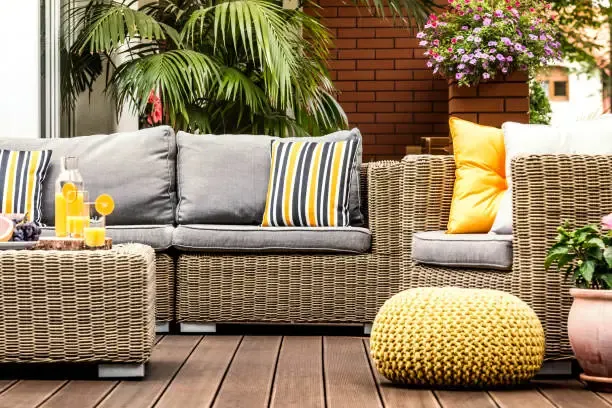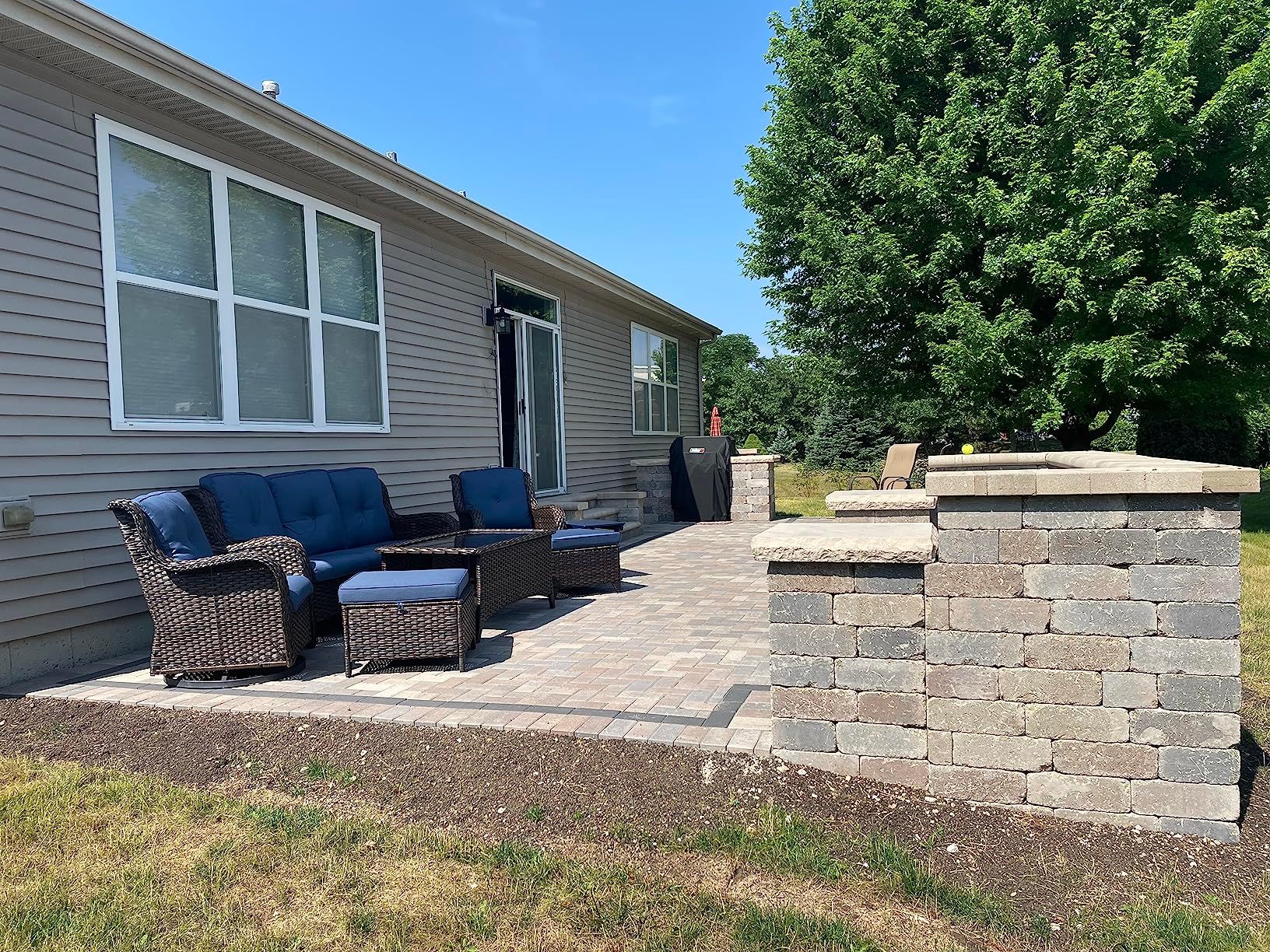
Is it OK to Put Patio Furniture on Grass?
Share
Setting up a comfortable outdoor seating area can be a game-changer for your backyard gatherings, barbecues, or even just a quiet morning coffee. But if you don’t have a deck or patio, you might be wondering: Is it OK to put patio furniture on grass? It’s a practical question with answers that can help you enjoy your outdoor space without damaging your lawn. In this blog, we’ll dive into the pros and cons of placing patio furniture on grass, share some tips on protecting your lawn, and suggest the best types of furniture for grassy areas.
Pros and Cons of Putting Patio Furniture on Grass
Putting patio furniture directly on your grass can create a cozy, laid-back vibe that’s perfect for enjoying nature. But, as with most things, there are pros and cons to consider.
Pros:
Easy Setup: No need to pour concrete or build a deck. Just place your furniture on the grass, and you’re good to go!
Natural Aesthetic: Grass gives a fresh, natural feel that’s appealing and great for outdoor aesthetics. It makes your space feel more connected to nature.
Flexible Layout: You can easily move the furniture around, changing the setup whenever you want to switch things up.
Cost-Effective: You save on the costs associated with building a hard surface like a deck or patio. It's a budget-friendly way to create a cozy spot in your yard.
Cons:
Grass Damage: Patio furniture can flatten or kill the grass over time, especially if it’s heavy or left in the same spot for too long.
Stability Issues: Furniture on grass can be wobbly, especially if the ground is uneven. This can make it uncomfortable or even unsafe for your guests.
Moisture and Rust: Grass can hold moisture, which can lead to rust or mildew on certain types of furniture, especially those made of metal or untreated wood.
Difficult Maintenance: Mowing the lawn around your furniture can be a hassle. You’ll likely need to move the pieces each time you need to cut the grass.
Tips to Protect Your Grass
If you decide that the pros outweigh the cons, here are some tips to help you protect your grass while keeping your patio furniture on it:
Rotate the Furniture Regularly: Moving your furniture around every few days can prevent the grass from getting worn down in one spot. This also helps the grass recover from any weight damage.
Use Furniture Pads or Coasters: Placing pads, coasters, or even small planks of wood under the legs of your furniture can help distribute the weight and minimize grass damage.
Opt for Lightweight Furniture: Choose lighter furniture that doesn’t put as much pressure on the grass. Think along the lines of wicker, rattan, or lightweight aluminum.
Add a Rug: Outdoor rugs can help create a barrier between your furniture and the grass. Just make sure the rug is breathable so that it doesn’t trap moisture underneath.
Lift, Don’t Drag: When moving furniture, lift it instead of dragging it across the grass. Dragging can tear up the lawn and cause more damage.
Limit the Time on Grass: If possible, bring your furniture in after use, especially if it's prone to weather damage or is placed in a high-traffic area.
Best Types of Patio Furniture for Grass
Some types of furniture are better suited for placement on grass than others. Here’s a look at the best options to consider:
Wicker and Rattan Furniture: Lightweight and easy to move, wicker and rattan are great choices for grassy areas. They’re also typically weather-resistant, making them ideal for outdoor use.
Folding Chairs and Tables: These are easy to set up and store when not in use, minimizing the time they spend on the grass and thus reducing potential damage.
Plastic Patio Sets: While not the most stylish, plastic furniture is light and durable, making it a practical option. Plus, it’s resistant to moisture and won’t rust.
Aluminum Furniture: Aluminum is light, durable, and doesn’t rust easily. It’s a great choice if you want something sturdy but still manageable on grassy areas.
Outdoor Bean Bags or Floor Cushions: For a relaxed, casual vibe, outdoor bean bags or floor cushions can be perfect. They’re lightweight and can easily be moved around as needed.
Alternatives to Placing Patio Furniture on Grass
If the cons outweigh the pros for you, don’t worry. There are plenty of alternatives that can provide a better, more durable surface for your outdoor furniture:
Patio Tiles or Pavers Patio tiles and pavers are a popular option for homeowners looking to create a more solid, durable surface for their outdoor furniture. These materials provide a stable and level foundation, preventing your furniture from sinking into the grass or becoming uneven. They are available in various styles, colors, and materials, so you can choose the one that best suits your aesthetic.
Decking Building a deck or patio is another great alternative. A deck provides a solid, level foundation that can support heavier furniture and withstand the elements better than grass. If you prefer wood, composite decking can be an excellent choice for durability and low maintenance.
Gravel or Crushed Stone If you’re looking for a low-maintenance yet functional alternative, gravel or crushed stone can be a great choice. This type of surface provides excellent drainage, prevents weeds from growing, and creates a level area for your patio furniture. It’s also cost-effective and easy to install.
Outdoor Rugs or Mats If you’re determined to keep the grass underfoot but want a more stable, clean surface for your furniture, outdoor rugs or mats are a fantastic solution. These rugs are specifically designed for outdoor use and can protect both your furniture and the grass underneath. They can also add a touch of style and comfort to your outdoor space.
Artificial Grass For a hassle-free, maintenance-free alternative, you can opt for artificial grass. Synthetic grass provides the aesthetic benefits of natural grass without the drawbacks of maintenance and damage. It’s a durable surface that doesn’t require mowing or watering and can support furniture without causing indentations or unsightly patches.
Maintaining Your Outdoor Space
To keep your lawn looking lush and green, consider incorporating some maintenance routines:
Regular Mowing: Keep your grass at a manageable height to prevent any uneven areas that could affect your furniture’s stability.
Aerate the Lawn: Aerating helps your grass recover by allowing more air and nutrients to reach the roots. This is especially helpful if your grass gets compacted under heavy furniture.
Water and Fertilize: Ensure your grass is well-fed and hydrated, especially in spots where furniture is placed. This will help it bounce back quicker.
Repair Damaged Areas: If your grass gets damaged, consider reseeding or using lawn patches to fix the affected spots.
Conclusion
So, is it OK to put patio furniture on grass? Absolutely, but with a little care and planning. By rotating your furniture, using protective pads, and choosing the right types of furniture, you can enjoy a beautiful and functional outdoor space without ruining your lawn. With these tips, you’ll be able to relax in your grassy paradise all season long.


